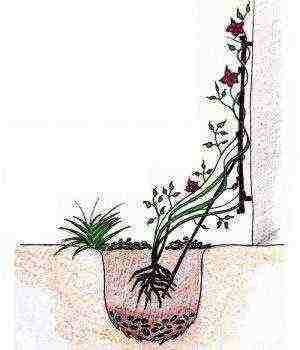Content
- 1 What is this plant?
- 2 How to grow?
- 3 How to care?
- 4 Problems
- 5 Description of the plant
- 6 Types of balsams
- 7 Balsam: home care
- 8 Reproduction of balsam
- 9 Balsam diseases and their treatment
- 10 Growing features
- 11 Features of a houseplant
- 12 When does a flower need a transplant?
- 13 When is the best time to do it?
- 14 Preparing soil and pot
- 15 Algorithm of actions at home
- 16 Conditions and time
- 17 Moving a plant to open ground
- 18 Photo
- 19 How to look after in the coming weeks?
Professional flower growers and just lovers of indoor flowers have a lot of plants, but among them there are the most beautiful and beloved ones. And many people really like romantic balsam. How to properly care for him?
What is this plant?
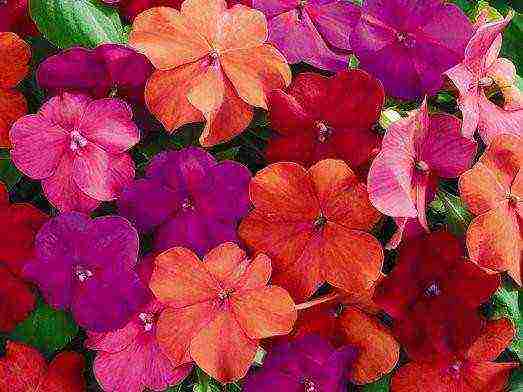
Balsam is the general name for a family of perennial or annual herbaceous plants, which are mostly shrubs. It includes only two genera: Impatiens, as well as monotypic, that is, consisting of only one representative of Hydrocera.
The people have other names for such a plant. The most common is “touch-me-not” (this is how the name of the genus Impatiens is translated). And this is due to the fact that after pollination, the balsam forms capsules with seeds that literally explode from any slightest touch.
Another name for the flower is "Vanka wet". And it is explained by the fact that after watering, drops appear on the tips of the leaves, the so-called sweet tears, which can be sugared. Also balsam is called "light" for its bright flowers.
The balsam looks like a small bush with oblong leaves, usually green, variegated, burgundy or even red. The photo shows that the flowers are bright, can have an unusual shape and interestingly located petals. The color can be white, orange, yellow, purple or red. There are also two-color petals. By the way, perennial balsams can bloom literally all year long, if, of course, they are properly looked after.
The most common plant species are touch-me-not balsam, Waller's balsam, the so-called New Guinea balsam (hybrid), touch-sensitive glandular, as well as common.
How to grow?
How to grow indoor balsam? The easiest way is to buy an adult potted plant. But in this case, the flower, due to a change in conditions and fertilizers, can get sick and die. If you want to see your balsam "from an early age", then try growing it from cuttings or seeds. See below for more details on each method.
Growing from seeds
If you decide to grow balsam from a seed, then place a few seeds in the ground (preferably in a wide container), and then water it. Next, the pot needs to be covered with a film, this will create a greenhouse effect and increase the germination rate.

It is best to grow the plant at temperatures between 20 and 25 degrees. And the ideal soil for the emergence of the first shoots will be a mixture of turf and humus. Moisten and ventilate the soil regularly, and when sprouts appear, plant them, that is, dive. Pick the strongest shoot and plant it in a full pot.
Growing from cuttings
Cutting is the easiest and fastest way to propagate and grow. Just use a knife to cut off a young but well-strengthened side shoot and place it in the water (rather deep, otherwise it may dry out). When the roots appear, you can plant the cutting in the ground.
How to care?
Caring for balsams includes several important points.
The correct pot
The pot must correspond to the size of the plant, since the balsam will not be able to receive moisture and nutrients from an excessively large volume of soil, and in a cramped "dwelling" it will be uncomfortable, which will affect development and flowering. The container should not be too wide and flat, the height can be equal to or slightly larger than the diameter. There must be a hole in the bottom, excess moisture will leave through it.

Separately, it is worth writing about the pallet. It should be quite high, since the next day after watering, the plant begins to suck out the remaining moisture, and in significant quantities.
By the way, balsam can grow well both at home on the windowsill and in the garden. But when grown in an open space in the fall, the flower will need to be transplanted into a pot and removed to the house.
Suitable soil
You can buy ready-made soil for flowering plants in the store, it is quite suitable. A mixture consisting of equal parts of humus, turf and sand will also be favorable for growth. If you want to provide your balsam with ideal conditions, then you can prepare a more complex composition of peat, sand, humus, as well as sod and leafy lands. At the bottom of the pot, be sure to put a layer of drainage, which may consist of expanded clay or broken brick.
Lighting
Balsam is considered a light-loving plant, so light should be sufficient. It will feel good in direct and bright sunlight, but if there is a lack of moisture, in this case it can dry out. To avoid this, shade the area during hours of high solar activity.
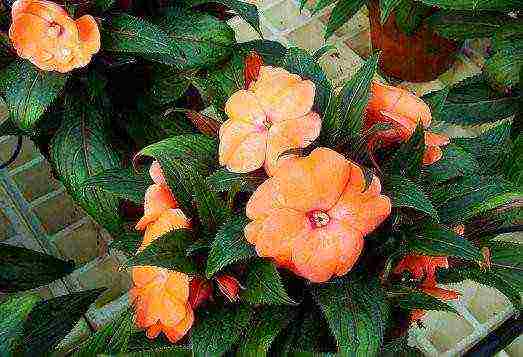
Diffused light will do. If you grow the plant at home, then place the pot on the east or west window, covering it with curtains or blinds. In a shaded area, the flower will also grow, but much more slowly and practically without buds.
Watering
Watering such a delicate and beautiful flower should be plentiful, especially in the warm season. In the summer, you can water it after one or two days, and in the winter it is better to do it a couple of times a week. Ideally, the soil should always remain slightly damp, otherwise the leaves may begin to wilt and dry out. The lower the temperature, the lower the volume of water should be.
Temperature
The optimum temperature for balsam is considered to be in the range of 20-25 degrees in the warm season. In winter, it is advisable to reduce it to about 15 degrees. If the room is very warm or hot, then regularly ventilate it, but during the procedure, it is advisable to remove the pot from the window to protect the plant from drafts.
Air humidity
Air humidity should be medium, that is, within the range of 50-60%. If it is low, then use a humidifier or put expanded clay in a pan and water it so that the moisture evaporates actively. And in the summer you can spray the leaves. But this should be done in the early morning, since when such a procedure is carried out during the day, drops of water under the influence of sunlight can cause burns.
Top dressing
You can feed balsam throughout the year, about once a month, this will ensure year-round flowering. If you do not need numerous buds, then fertilization is enough only during the active growing season once every two weeks. For feeding, you can use any complex formulations for flowering plants or indoor flowers.
Transfer
It is advisable to transplant in the spring. Young balsam should be transplanted about once a year, and an adult should be transplanted as it grows, that is, every two to three years.During the procedure, you should be more careful with the roots, it is advisable to remove them along with the soil.
Pruning
If you want to make the bush more lush, then you can cut off the upper shoots in the spring. By the way, they can be used for reproduction.
Problems
Possible problems:
- Pests. Balsam can infect spider mites, aphids, whiteflies and sciarids. Such insects can fly from the street or from another houseplant.
- If the leaves curl, begin to rot or fall out, then most likely the balsam lacks light or moisture.
- If you notice the dropping of flowers and buds, then the plant is probably cold. Also, insufficient lighting may be the cause of this symptom.
- Due to excess and stagnant water, balsam can begin to rot. But the most dangerous consequence is decay of the root system, which can lead to the death of balsam.
- If the plant is barely blooming, you probably chose a pot that is too large. You can also try to start fertilizing the soil regularly, lack of nutrients can also lead to a lack of buds.
Take care of your plants so that they always delight you with their beautiful flowers!
This is one of the traditional potted crops. Among the people, she has many other names: "Vanka wet", "Zealous Liza", "touchy", "light". The appearance of nicknames is facilitated by various features of the plant: to emit dew, to spew out seeds from the box when touched. The natural habitat is tropical and subtropical forests. Homeland - Africa and Asia.
Content:
- Growing and caring for a flower
- Locations, lighting and temperature
- Watering and humidity
- Pot selection
- Soil and fertilizers
- Plant pruning
- Balsam transplant
- Pests and diseases
- Powdery mildew
- Thrips
- Flower propagation
- Cuttings
- How to choose a healthy plant in the store
- The most common types
Balsam is very picky about lighting, it should be long-lasting but without direct sunlight. It is better to water the flower often, but a little bit, you can also spray the plant to maintain moisture.
The abundantly flowering bush is unpretentious and, with proper care, is able to delight with its decorative effect for many years. The stem is thin with a smooth surface, reaching up to 40 cm. Leaves are dark green in color, oval oblong in shape. Each has a slight splash of noble purple color. The flowers have a wide colorful palette: yellow with purple, burgundy with pink, purple with white, and others. Flowering takes place almost without interruption during the whole warm season.
Growing and caring for a flower
Locations, lighting and temperature
Herbaceous flora loves light very much... His favorite place in the house will be the south-facing window. Do not forget about the harmful effects of direct sunlight, especially through glass. Bright juicy foliage is threatened with burns.
On hot days, artificial shading is installed, but only for the period of active solar activity. With the onset of cold weather, they remove it, but move the pot away from the glass. The balsam does not tolerate frost and cold. When choosing a room, it is worth considering the love of fresh air, but drafts should be avoided. If you place it incorrectly, then the light builds up the root mass, to the detriment of flowering. The shape of the crown becomes irregular, and the buds move to its very edge.
The subtropical past requires enough warmth. Despite the successful adaptation of the exotic to our climate, it does not survive the cold very well. From December to March, the room should not be less than 14 degrees Celsius, and in the rest of the months the permissible temperature is from 20 to 30 degrees, with sufficient humidity.
Watering and humidity
The plant needs frequent but moderate watering.
Moisture-loving handsome man unable to tolerate drought... By keeping the soil constantly moist, you can ensure long and lush bloom. With the onset of spring, more moisture is required; in the fall, watering is halved. Purified water is used at room temperature. It is not worth pouring it in. This can cause rotting of the root system.
Optimal: water little, but often... In summer, after watering, dew drops appear on the leaves and dry quickly. If an unforeseen situation happened, when there was no opportunity to "water" the zealous Liza and she dried up, then she can still be saved. The container is completely immersed in a pan with water for 2 hours. The liquid that is glass in the pan is poured the next day. Touch-me-not will come to life, but will be weak. It takes time to recover.
So that the vanka does not dry out wet, it is important to monitor the thermometer. As soon as it has risen above +22, additional security measures should be taken. A pallet is installed next to the flowerpot.
Pot selection
Required small. The pet does not like large vessels. For a lush bloom, the root system must completely envelop its interior. Otherwise, the balsam will only grow green mass until the roots fill the inside of the flowerpot.
If there is no opportunity to plant it in a small container, then you can use a large one, but for 2 bushes at once. A drainage layer is poured into each, without exception, container. It should be at least one third of the total volume of the substrate. The presence of through drainage holes is mandatory... Otherwise, the exotic is threatened with many diseases.
Soil and fertilizers
By choosing the right soil mixture, you can provide the plant with all the necessary growing conditions. Ideally, this is a light, nutritious soil. You can buy it at a flower shop - soil for flowering indoor plants. Or cook it yourself from the following ingredients:
- humus;
- sod land;
- sand in equal parts.
Mix everything thoroughly and add 1/2 part of peat. Heavy soils impede growth and full development.
In winter, fertilizers should not be completely abandoned. Support is provided in small portions once a month. Has a beneficial effect on the plant this season nitrogen feeding... The active fertilization phase begins immediately after coming out of dormancy. For primary support, a phosphorus-potassium mixture is used. It is brought in 2 times a month. But observing certain rules: fertilizers include only healthy specimens in the "diet"; during rest and for a month after the transplant, support is not required; you need to make strictly the amount indicated on the packaging by the manufacturer.
An excess of supplemental nutrition has a negative impact on health.
Plant pruning
Held in the spring. The stems are shortened if they have grown, and the crown has lost its attractiveness. You can trim them by no more than one third. And if the length is optimal, but growth stimulation is required, then pinch the stems. Thus, the bush is rejuvenated, and the trimmed fragments are used for the purpose of reproduction.
Balsam transplant
It is carried out every year and after purchase. To avoid stress, they do it in the spring, as soon as active growth begins. Changing the pot has a positive effect on the emergence of new shoots and the size of the buds.
Experienced gardeners it is advised to carry out the procedure 2 times a year: in autumn and spring... So they protect the culture from diseases, loss of attractiveness and stimulate the formation of a voluminous and dense bush.
Pests and diseases Powdery mildew
Powdery mildew
Most harmful. The growth of infection is facilitated by: cool air, stagnant moisture and non-compliance with the rules for care. The pathogen enters the inside of the fire along with moisture. After 3-4 days, spots appear on the stems, which are replaced by a whitish bloom and the leaves die off. They darken and fall off.In order to prevent the death of balsam, you need to act quickly.
First of all, the frequency of humidification changes - they become scarce. In this way, dew can be prevented. The room is systematically ventilated, avoiding drafts. All affected parts are removed, and healthy ones are thoroughly sprayed with insecticides.
Thrips
Thrips - can harm the plant, if found, the plant should be treated
A sure sign of uninvited guests is the deformation of young shoots. Gradually, pests colonize an increasing area and new symptoms appear. The tips of the leaves begin to turn yellow, the flower's immunity is weakened, brown spots appear, and decorativeness is lost. The ill, diligent Lisa is quarantined and treated with insecticides. All affected parts are removed and burned.
Flower propagation
Cuttings
This method retains all the characteristics of the mother "individual". Cut off the planting material during transplantation. Choose a branch without buds. The optimal length is 9-11 cm. Each must have at least 2 internodes. The lower leaves are cut off.
Rooting methods:
- water... The immersion takes place down to the foliage. It is not worth wetting it, so that rotting does not begin. The branch needs a well-lit space with warm air. The root system will begin to develop immediately and after 2 weeks the cuttings can be transplanted into the soil.
- priming... The grounding of a healthy cutting is shallow. You can prepare a suitable substrate with your own hands: peat and vermiculite in equal parts, 2 parts of perlite. It should always be slightly moisturized. After watering, shallow loosening is recommended for oxygenation.
How to choose a healthy plant in the store
A close inspection of the touch-me-not will help you quickly and very accurately determine whether the plant is healthy and worth purchasing. Signs of a sick Vanka wet:
- dry foliage tips, spots, streaks, plaque and lethargy;
- pale color, small flowers and buds;
- obvious signs of insects;
- irregular, deformed crown shape.
- unpleasant smell.
If none of the above symptoms are present, then you can agree to the purchase. After being transported home, he is given a secluded corner, without bright light. It is obligatory to transplant and unhurried introduction of irrigation regime, fertilizers, etc. It takes time to adapt.
The most common types
The vast family includes many amazing representatives:
- garden;
- Waller;
- terry;
- Impreza;
- Hocker;
- New Guinea.
For those who want to decorate their home with indoor flowers, an unpretentious, but very beautiful balsam flower is the best fit. This plant has other names, such as Ogonyok, Vanka wet and Zvezdochka.
Caring for indoor balsam at home allows you to ensure its year-round flowering, which will delight all households.

There is a similar article on this topic - Garden balsam: planting and care, growing from seeds.
Description of the plant
The plant takes root well and feels great on a windowsill in a pot. It is loved by flower growers for its constant flowering and easy maintenance. Its natural habitat is subtropics.
It is still found in the wild in the subtropical climates of India, Africa and North America. The flower came to Europe at the end of the 16th century and took root perfectly. It was brought to Russia only in the 19th century.
The plant species common in Russia have succulent and brittle stems with a fibrous root system.
Its leaves are oval or heart-like, tapering at the beginning, and expanding closer to the petiole.
Their edges have a serrated edge with small or large teeth, ending in a small spine.
The saturation of the color of the leaves depends on its type. In Russia, flower growers usually breed plants with light or rich green leaves.There are also types of balsam with dark green leaves with a lilac or brown tint. The veins are clearly visible on the sheet, having a color one tone lower than it.
The flowers of the plant have 5 petals and they are painted in different colors: pink, red or pale pink. There are varieties with two-color flowers: cherry, orange, white, as well as those with rose-shaped buds, double and semi-double petals.
Faded buds form green fruits, which, when ripe, form a dry capsule.
Types of balsams
Currently, more than 400 varieties of the presented plant are known. They can be both annual and perennial. Balsam blooms magnificently and has a different color of buds. The most popular types of balsam are:
Waller
- bushy plant up to half a meter tall. On its basis, numerous hybrids have been bred. It has erect juicy stems, tender wide oval-shaped leaves of a green or brownish tone. The plant loves warmth and light, so you should choose an appropriate room for it.
 New guinea
New guinea
- a hybrid plant with large flowers of bright colors. This perennial plant can be grown outdoors and in pots as an indoor plant. Their leaves have bright saturated shades of green with yellow veins. The variety especially needs warmth and light, so you need to choose the sunny side of the room for them.
 Kandy
Kandy
Is a young variety, recently bred. The bush has stems up to half a meter long, petioles with leaves extend from them. The leaves are oblong with a pointed tip, in various shades of green. It blooms profusely, the buds on high pedicels have different colors. The flowers are soft and velvety to the touch.
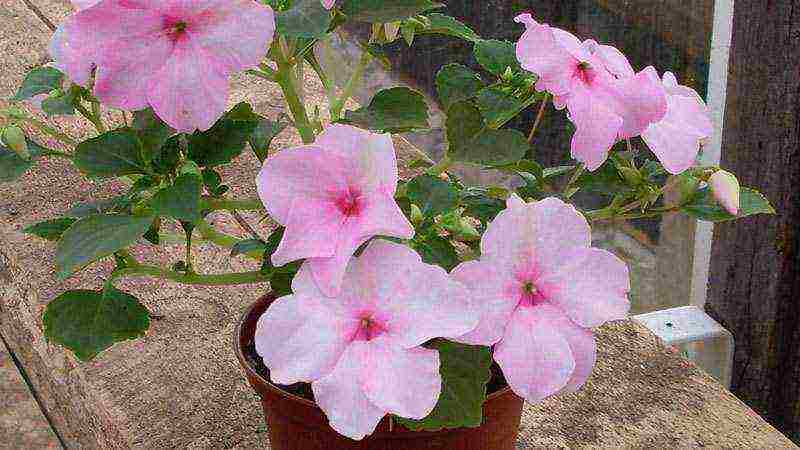
These are only the main types of plants that are found in Russia among flower growers. They are unpretentious in cultivation, so the choice falls on them.
There are a huge number of varieties that are also grown in the country, but they require some painstaking care, which not every novice grower can do.
Balsam: home care
The plant thrives in a bright room at home and gives abundant flowering. Vanka wet is not at all demanding in careful care, but still we must not forget to water and fertilize him.
If a mistake is made in the care, then the plant drops its leaves.
Balsam blooms from early spring to late autumn, rests briefly in winter and again pleases the eye with bright flowers.
How to care for balsam is represented by the following factors.
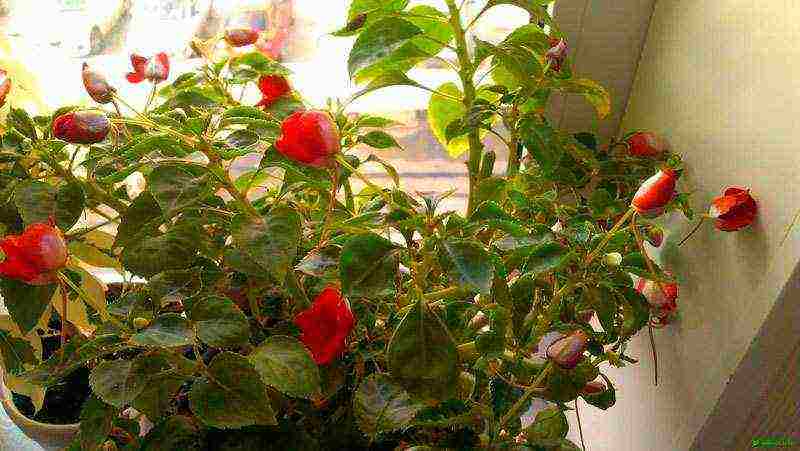
Priming
To make the flower feel comfortable, it needs a small pot for the size of the root system and a small amount of soil. The soil for the plant does not matter, as long as it is moderately loose and nutritious.
It is impossible to oversaturate it with minerals, ammonium nitrate and ammonium sulfate, otherwise the green mass will riot, but a small amount of buds will bloom or will not appear at all.
For planting, you need to choose a mixture with low acidity: two parts of sod, leafy soil, humus, sand, add one part of peat.

Top dressing
During the period of abundant flowering, the plant needs feeding. This is the period from early spring to late autumn. Once every two weeks, it must be watered with fertilizer for flowering plants. At the end of August, it is required to reduce the number of dressings and fertilize once a month until February.
Fertilizer should be applied to a moist substrate, immediately after watering. In winter, when the dormant period begins, but buds appear, it is necessary to feed the balsam with not very concentrated mineral fertilizers.

Watering
The plant consumes a lot of moisture. Lack of it leads to a loss of elasticity of the stems and shedding of leaves. Watering is carried out according to the following rules:
- It is recommended to take soft, settled water.
- When the top of the soil is covered with a white bloom, it must be removed and covered with fresh soil. The reason for this is too hard water, increased alkalization of the soil.
- Watering should be done by moving along the edge of the pot so as not to fall on the root collar.
- In summer, it is required to water the plant every other day, and in winter it will be enough once a week.
- Do not allow the earthen coma to dry out.

- Do not allow water to stagnate in the sump.
- Make the substrate slightly damp, but not wet.
- If the room temperature is more than 20 degrees, then the flower should be sprayed.
- From time to time it is necessary to loosen the soil in the pot to a depth of one centimeter so that the roots can "breathe".
Lack of moisture provokes plant lag in growth, and the buds will dry out and fall off.
Lighting
Although the balsam loves normal lighting, the direct rays of the sun are unpleasant for him, because they can provoke a burn on the leaves.
Therefore, if the pot is on the sunny side, the window should be shaded.
But in winter, natural light is not enough for it, so it is necessary to supplement it with artificial light, install a lamp nearby.
If this is done, then the balsam will bloom in winter.
In order for the bush to have a beautiful and even crown, it is necessary to periodically turn the pot to the sunny side from different sides. With a lack of light, the plant will stop throwing out buds and will not bloom, losing all its beauty.
Fresh air is necessary for the plant, so you need to regularly ventilate the room where it stands, but beware of drafts.
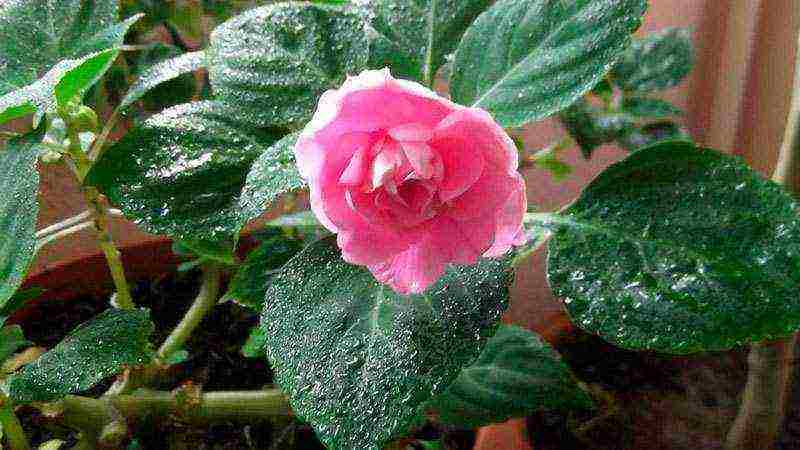
Indoor temperature and humidity
In the warm period, the plant keeps well even at a temperature of 25 degrees, if the room is regularly ventilated, and the soil in the pot is moist.
In cold weather, temperatures should not be allowed below 10-15 degrees.
The flower feels good in moderate humidity, if the temperature does not go over 22 degrees.
If the temperature rises higher, the soil dries out quickly and the plant begins to wilt. It can be saved by daily spraying, which must be carried out carefully, not getting on the buds and flowers.
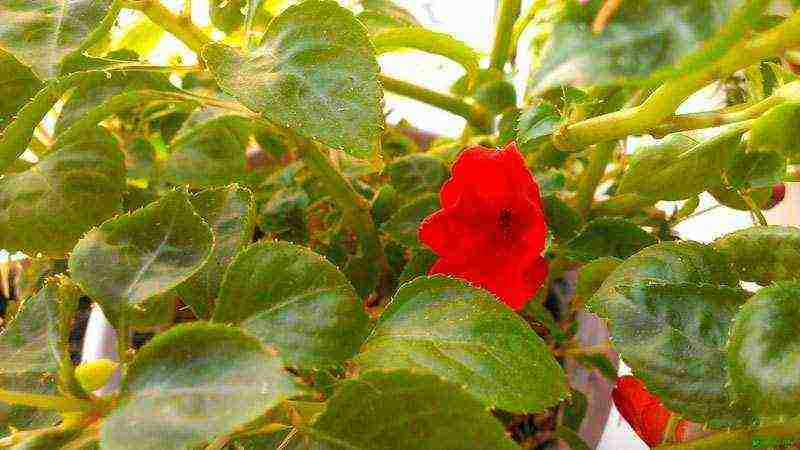
Transfer
The transplant is usually carried out in the spring, but, if required, then in the summer. Young bushes require replanting annually. Adult bushes are either transplanted or renewed by rooting cuttings from the tops of the shoots, because balsam grows over time and becomes ugly.
The pot should be chosen according to the size of the root system. When it is too small, then the plant will be more lush. For this, some plant 2-3 roots in one pot.
The soil for transplanting should not be taken too nutritious, otherwise the green mass will begin to gain strength, and flowering will slow down.
It is best to take a mixture of turf soil, humus, compost and perlite, mixed in equal parts, the soil will be light and breathable. It is important to provide the plant with good drainage.
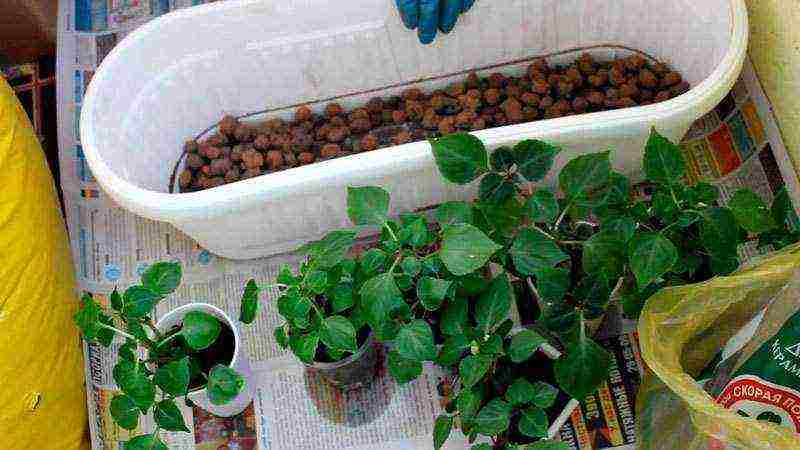
Pruning
Usually carried out in the spring during transplantation. Branches that have grown strongly over the winter are cut off to almost half the length. The shoots that have grown to the required length are pinched to form branches with peduncles.
The pruning process rejuvenates the plants. The cut tops of the shoots are used for plant propagation.
To improve the appearance of the bush, cut off the bare branches, as well as dying leaves and flowers.
Reproduction of balsam
The balsam plant propagates in two ways: by seed and cuttings. Correct planting and care promotes lush flowering in the first year of life.
Cuttings take root well in water, put down roots. It is more difficult to propagate by seeds, the flowering of such a plant begins after 4 months.
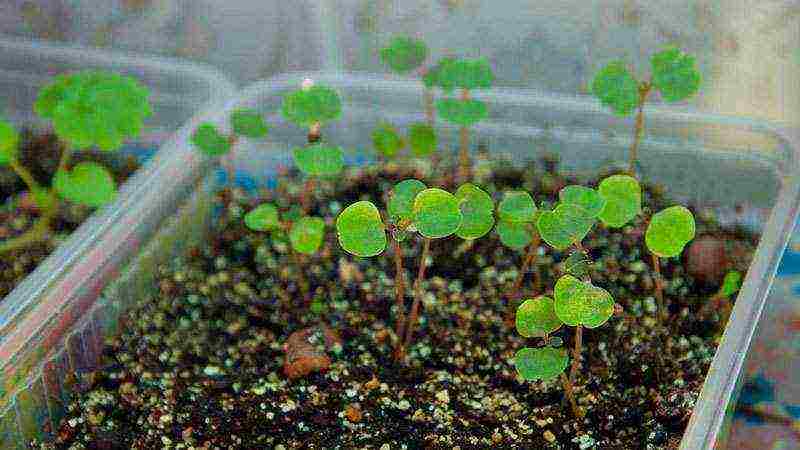
Growing from seeds
Planting can be done all year round. The breeding order is presented in the sequence:
- Before planting, the seeds are soaked in a weak solution of potassium permanganate for 10 minutes.
- The soil for them is mixed from a part of perlite and two parts of peat.
- Deepen the seeds by 7 cm and moisten the soil, close the pot with a film so that the temperature under it is 20-25 degrees.
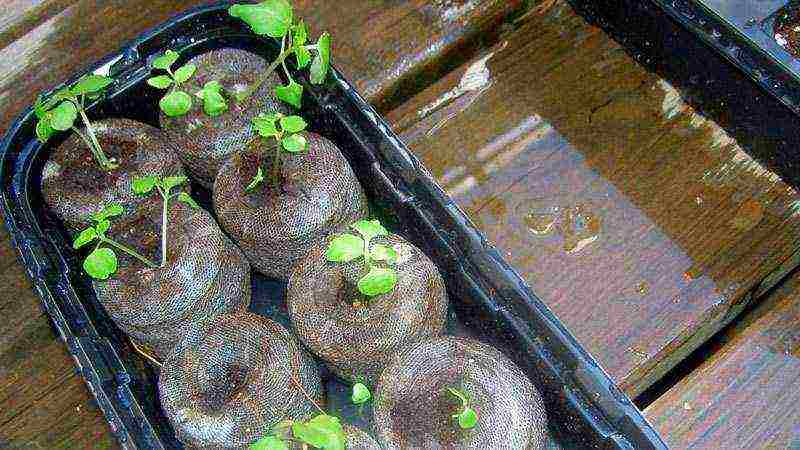
- Sprouts appear in 8-10 days.
- To prevent the soil from being too wet, it must be ventilated periodically.
- After the seedlings reach a height of 1.5-2 cm, it must be dived.
- You can distribute seedlings in pots when at least one full-fledged leaf appears in her.
It is important to follow the sequence so as not to provoke the death of new shoots.
Propagation by cuttings
This is the more popular breeding method. At the same time, all species characteristics are preserved. This method is especially good for terry balsam varieties. The breeding order is suggested as follows:
- In spring or summer, the top of the shoot is cut to a length of 7 cm. 2-3 internodes should be present on the cuttings. The lower leaves can be removed.
- Place the stalk in a bowl of water and wait for the roots to appear.
- The substrate for planting is the same.
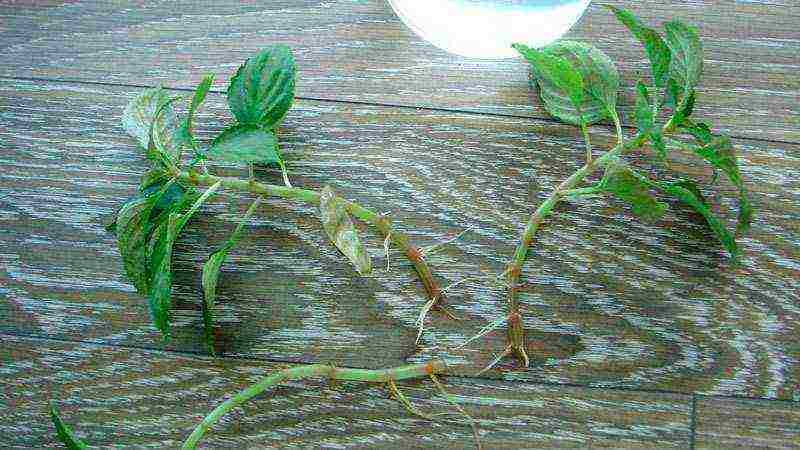
- After the roots appear, they are planted in pots, which need to be covered with something, for example, a jar.
- Seedlings take root in 2 weeks, and after 2-3 months the bush begins to bloom.
Experienced growers plant cuttings directly into the ground, having previously treated them with a preparation to accelerate the growth of the root system. The stalk takes root just as well if it is created in greenhouse conditions.
How to propagate balsam? Video:
Balsam diseases and their treatment
Balsam, like all indoor plants, is susceptible to various diseases - viral and fungal. The most common are:
1. Mosaic - viruses of spotted oppression. The disease is noticeable by the deformed leaves of the plant, yellow spots on them, the wilting stem and the cessation of flower growth. Insect pests infest the plant. You can eliminate the disease with the help of insecticides.
2. Gray rot is a fungal infection. Its appearance is visible on the brown spots on the leaves, white bloom and sluggish stems. Infection occurs with improper plant care.
Treatment is carried out with antifungal agents - fungicides and proper care of the bush. Usually the fungus infects the soil, so it is better to transplant the bush into a new clean soil.

3. Bronze is a viral disease that does not respond to treatment. The disease can be seen by withering leaves and stems, deformation of leaves, the formation of holes of different sizes on them.
Bacteriosis is a very dangerous disease, so the bush must be immediately destroyed so as not to infect other plants.
To prevent contamination, it is necessary to frequently ventilate the room.
4. Powdery mildew is a fungal infection that often develops in the soil of indoor plants. The disease is noticeable by the wilting of the bush, the appearance of a whitish-brown bloom on the leaves and twisting them into tubes.
Pay attention to this material - Unpretentious and shade-loving indoor plants.
Treatment with solutions of copper sulfate, soap solution, soda ash helps. It is required to feed the bush with phosphorus-potassium fertilizers.
These are almost all diseases of balsam, which must be quickly eliminated so that the bush does not suffer and the disease does not spread to other plants.
You will be interested in this article - Yucca: home care, reproduction and transplantation.
Balsam treatment. Video:
Growing features
There can be other problems when growing balsam. The most common are:
- Why do balsam buds fall off? This situation happens with poor care of it, when the air in the room is dry and insufficient watering, it is too cold and dark, and also when the bush is overfed with fertilizers.
- Why do balsam leaves turn yellow? This is due to a lack of moisture or sunburn if the pot is in direct sunlight. In winter, the leaves may turn yellow due to low indoor temperatures.

- Pests attacking the bush - whitefly and spider mites, appear when the room is too dry and in the heat, if it is not ventilated. The plant should be properly looked after.
Beautiful and easy to care for, balsam is able to delight you with its bright and delicate flowers all year round, if it is properly looked after and treated for diseases in time.
Like the article ? Show it to your friends:
Features of a houseplant
This plant has low shoots prone to branching. The leaves are green, there is a reddish or bronze overflow. If there is high humidity in the room, then water droplets form at the tips of the leaves.... Because of this feature, the balsam is also called Vanka-wet.
Due to their beautiful and low bushes, they grow a flower as an ampelous plant. Balsam has axillary flowers. Their color is different, depending on the variety. They can be variegated, strewn with stripes or dots. Breeders managed to breed terry varieties.
When does a flower need a transplant?
There are the following indications for a flower transplant:
 Planned transplant... Replacement of soil is required, pruning of elongated shoots that have lost their decorative appearance. Old soil is depleted and dries up quickly. After transplanting, the plant will begin to grow faster, the roots will receive additional space for growth, the access of water and air will increase.
Planned transplant... Replacement of soil is required, pruning of elongated shoots that have lost their decorative appearance. Old soil is depleted and dries up quickly. After transplanting, the plant will begin to grow faster, the roots will receive additional space for growth, the access of water and air will increase.- After the purchase... The newly purchased balsam must be transplanted into a new pot and fresh substrate. Only do this on condition that the plant does not bloom.
- Not enough storage... If roots become visible from the drainage hole, then this is a signal to replace the pot. For further development, the flower needs more space. The new pot should be 1-2 cm larger than the previous one.
When is the best time to do it?
A planned balsam transplant is carried out every spring before flowering.... But some growers change touchy ground 2 times a year - before and after flowering.
Important! Transplanting is not recommended during bud formation and inflorescence. Otherwise, flowering will stop immediately.
Preparing soil and pot
When choosing a container for balsam, keep in mind that its roots are underdeveloped and short, the roots are shallow. When buying a large and capacious container, most of the soil will be empty, and the roots will be located at the top. This will cause acidification of the substrate and rotting of the root system.
Another option is possible: the flower will begin to actively develop and grow stems with roots, increase the green mass. All forces will be spent on this, and there will be no more of them left for the formation of inflorescences. A shallow pot remains suitable, the diameter of which is 14-16 cm.
Balsam is not particularly picky about the ground. The main thing is that the soil is nutritious, loose and breathable. A ready-made substrate sold in a store is suitable for flowering plants.
You can prepare the soil with your own hands, if you combine the following components in equal proportions:
- peat;
- sand;
- sod land;
- sheet soil;
- humus.
Algorithm of actions at home
Balsam transplant is carried out as follows:
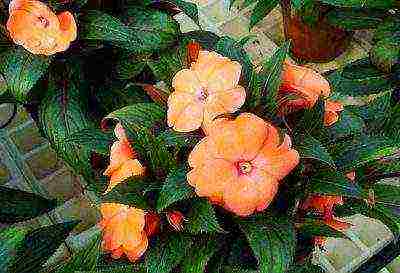 Before the upcoming events (per day), thoroughly water the soil.
Before the upcoming events (per day), thoroughly water the soil.- Carefully remove the plant from the old container.
- Shake off all the roots from the ground and assess their condition. Remove all dry, rotten, old and heavily entwined roots using a sharp knife.
- Disinfect the cut sites, sprinkle with wood ash or crushed activated carbon.
- Lay the substrate at the bottom of the new pot and carefully place the plant in it, straightening the root system.
- Pay attention to the location of the root collar. It should not be covered with soil. Leave it above the surface of the ground, but a few centimeters below the edge of the container.
- Fill with soil to the required level and tamp lightly.
- Gently water the newly transplanted flower and put it in the shade for rooting and acclimatization for 3-5 days.
Advice... If you choose a pot wider, then several balsams can be planted in it at once. At the same time, you can get an original and elegant composition if you use plants with inflorescences of different colors.
Watch a video on how you can transplant several balsams into one pot.
Conditions and time
How to plant correctly?
Immediately after buying balsam, it must be transplanted.... There is a certain algorithm of actions:
- Use a pot slightly larger than the previous one.
- Prepare a fresh earthen mixture or use a store-bought one. If the first option is chosen, then combine the following components: sod soil, humus, coarse river sand (8: 2: 1).
- Transfer the plant to a new container, pre-moisten the soil.
- Pour the earth to the edges of the pot, but do not tamp it.
- Water gently and set on a windowsill out of direct sunlight.
If the balsam was purchased in winter, then it is not worth replanting it until spring. At rest, the flower will not tolerate such a procedure. When buying a blooming balsam, you need to wait until the buds fall off.
Before planting activities, you need to carefully assess the condition of the root system.... Healthy roots should be completely entwined with an earthen ball. It is advisable to shake off the ground and rinse the roots only if rot, diseases or insects are found.
How to root?
Rooting of balsam occurs in two ways:
-
 In the substrate... A landless mixture consisting of sand, perlite, vermiculite and peat is suitable for this. In such a substrate, even weak and young tops can be rooted. Plant the cuttings in small depressions and sprinkle with a landless mixture.
In the substrate... A landless mixture consisting of sand, perlite, vermiculite and peat is suitable for this. In such a substrate, even weak and young tops can be rooted. Plant the cuttings in small depressions and sprinkle with a landless mixture.
Drizzle with a slightly concentrated solution of potassium permanganate and cover with polyethylene. Due to the greenhouse effect, moisture and heat are constantly retained inside.
-
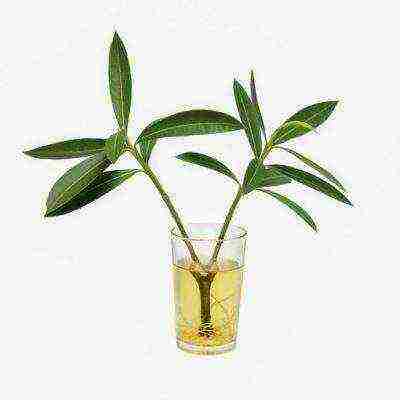 In water... Prepare soft warm water, pour it into a suitable container, such as a plastic cup.
In water... Prepare soft warm water, pour it into a suitable container, such as a plastic cup.
Then it is imperative to remove the lower leaves from the cutting and set it in water to a depth of 4 cm.
The roots will appear quickly, within a week. Transplanting into the ground is possible provided that the length of the roots is already 2-3 cm.
Moving a plant to open ground
Before transplanting a plant into open ground, you need to find a suitable place for it., focusing on the following recommendations:
- Garden balsam is not picky about the choice of "neighbors". You can plant begonias, fuchsias, verbena near it.
- You can get active growth and long-term flowering if you plant a crop on the west or east side.
- For balsam, moisture stagnation, constant dampness, frequent cold and drafts are not allowed.
- The soil should be loose, nutritious and well-drained from expanded clay.
- The growth and development of the plant is negatively affected by heat and acidic soil. In such conditions, it stops blooming, and the leaves fall off.
- Before planting, be sure to fertilize the soil with humus.
When all the preparatory activities are over, then you can start landing directly:
- Thoroughly moisten the soil in which the seedlings are located. Do this 2-3 hours before planting.
- Run holes in the ground. Place them at a distance of 25-30 cm.
- Add fertilizer and water to each hole.
- Carefully remove the seedlings and transplant them into the prepared recess.
- Tamp the earth around each plant, mulch with sawdust. Mulch is a great way to protect the soil from overheating and to retain moisture in it.
Photo
Below you can see a photo of an indoor flower.




How to look after in the coming weeks?
Watering
A time interval of 2 days must be observed between waterings. The top layer should not dry out completely... Otherwise, the flower will begin to wither and wither.
But stagnation of water in the pan will also have a bad effect on the plant. So after 3-4 hours after watering, you need to pour it out. Otherwise, it is fraught with insect attack and the development of fungal diseases. Use soft, settled water for irrigation.
Humidity
Spray balsam during flowering if the temperature is above 21-22 degrees... The ingress of liquid on the inflorescences is unacceptable, otherwise it will lead to the development of ugly spots on delicate petals.
Place an open container with water near the plant during its flowering. This will maintain the optimum humidity.
Top dressing
Add the fertilizer to the water for irrigation and apply every 2 weeks throughout the flowering period... At this time, the plant will use up a lot of energy, so it needs to provide additional nutrition.
Important! Liquid mineral fertilizers intended for flowering plants will help to fill the lack of necessary substances. You can buy them at any garden store.
Diseases and pests
Garden balsam is exposed to the following diseases and pests:
-
 Cucumber mosaic... The leaves are damaged, their growth stops, they become wavy and become covered with yellow specks.
Cucumber mosaic... The leaves are damaged, their growth stops, they become wavy and become covered with yellow specks.
Tear off affected leaves. As a prophylaxis, an active fight against aphids is used, which is a carrier of the virus.
-
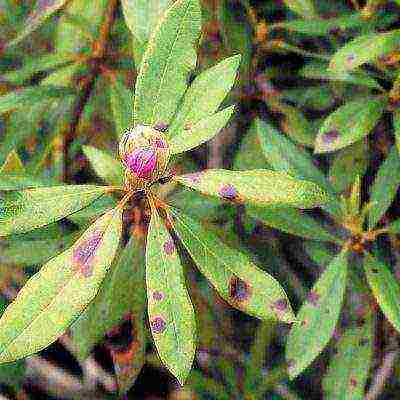 Ring mosaic... The leaves begin to stiffen, crack and become covered with spots that look like ring fingerprints.
Ring mosaic... The leaves begin to stiffen, crack and become covered with spots that look like ring fingerprints.
The plant gradually withers and dies. The affected leaves must be removed immediately.
-
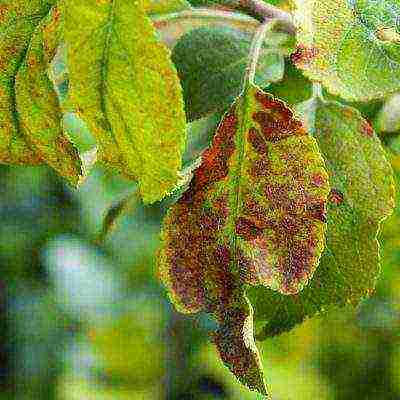 Bronze... The growth of leaves is inhibited, which leads to their deformation. As a result, they wrinkle and fall off.
Bronze... The growth of leaves is inhibited, which leads to their deformation. As a result, they wrinkle and fall off.
Plants affected by the virus cannot be saved, they must be disposed of, otherwise the disease can spread to other plants.
-
 Viral mosaic... The foliage becomes covered with yellow spots and becomes wavy.
Viral mosaic... The foliage becomes covered with yellow spots and becomes wavy.
For prevention, treat the plant with an agent against thrips and aphids (Decis Expert, Confidor), which spread the virus.
-
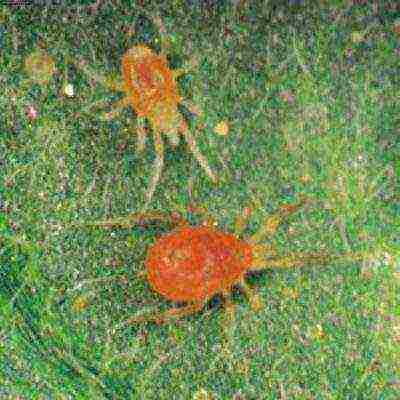 Spider mite... This insect weaves its web on the inside of the leaves, and then it eats them.
Spider mite... This insect weaves its web on the inside of the leaves, and then it eats them.
For prevention, treat with soapy water (1 liter of water and 40 g of soap). Remove the affected leaves.


